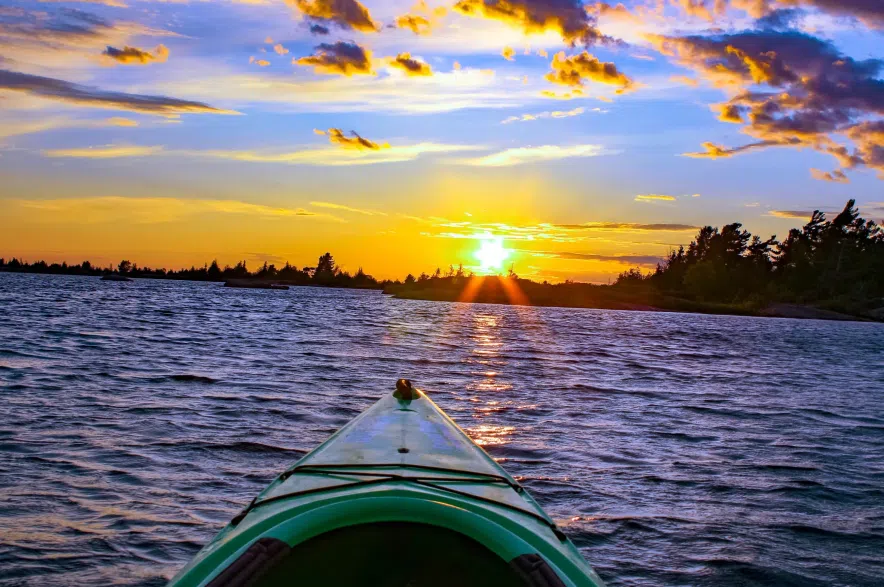Aquatic invasive species are a very real threat to waters in Saskatchewan and the provincial government is asking residents to do their part to help keep them in check.
According to a Saskatchewan Ministry of Environment news release this week, invasive species like zebra mussels and quagga mussels can be spread through recreational activities like fishing and boating, or though intentional means like releasing aquarium pets into the wild.
Once they have established a population in a body of water, they can be impossible to eliminate and can cost millions of dollars to properly manage.
Read more:
- Meewasin Valley Authority urges caution near South Saskatchewan River sandbars
- Saskatoon’s Prairie Lily ‘beached,’ rowing club concerned for athlete safety on South Saskatchewan River
- Sask. environment ministry offers advice on evicting bats from buildings
Jeri Geiger is the team lead for the Sask. government’s Aquatic Invasive Species Program, and said the clean, drain, dry method can go a long way in protecting our lakes and waterways.
“That’s why clean, drain, dry … procedures are really important as a prevention tool as well, not just as a tool to respond and contain spread once something gets here — there really is a big prevention piece to it as well,” she said.
Geiger said that an invasive species can pose multiple different risks if it’s introduced into a water source.
“It really depends on the species itself. But one key piece to what makes something invasive is it has the ability to negatively impact either the environment, the economy, or society — or potentially all three,” she said.
“In the case of zebra mussels or quagga mussels, for example, one of the biggest impacts is infrastructure, because they have the ability to attach to essentially any surface that is flat and hard.
“… when it comes to things like hydroelectric dams or drinking water intakes, those shells can very quickly clog intakes, which means either increased maintenance costs or increased replacement frequency for things like those water intakes or any kind of system like that,” said Geiger.
She explained that each step of the clean, drain and dry method is important.
“For cleaning, we want to make sure you have nothing attached to your boat … fragments of plants, mud (that) can carry things like snail eggs or invertebrates that are hard to see. We want to make sure everything is removed from the boat, you have nothing attached and nothing catching a ride,” she said.
“Next, we want to make sure the watercraft and the equipment are drained. … The bilge has to be drained, so those drain plugs need to be removed anytime you’re transporting watercraft. By law, you’re required to make sure that any standing water is drained out of your bilge,” said Geiger.
“Then, of course, there’s the dry phase and this is really important, not just for the watercraft, but for any equipment that is used in the water as well. We want to make sure it’s completely dry, because even the smallest amount of water can be carrying not only the invasives, but potentially things like eggs or larval stages of things like zebra and quagga mussels.”
“Our province, blessed with thousands of lakes and rivers, is a popular destination for anglers, boaters and others who enjoy recreation on the water,” Travis Keisig, Saskatchewan’s environment minister, said in the release.
“So far, our prevention efforts targeting zebra and quagga mussels have been successful — no invasive mussels have been found in Saskatchewan waterbodies.”

Saskatchewan’s environment ministry said proper decontamination of watercraft and equipment is the best way to help keep invasive mussels out of the province’s waters. (Government of Saskatchewan)
Last year, the ministry said it intercepted six watercraft that were carrying invasive species into the province and decontaminated more than 250 which were not properly cleaned, drained or dried and coming into Saskatchewan from high-risk areas.
Following the rules for cleaning, draining and drying watercraft, trailers and equipment is “the best way to prevent the spread” of harmful aquatic invasive species, the ministry noted in the release.
“This includes kayaks, canoes, paddleboards and any other equipment that may enter the water, such as life jackets and angling gear.”
The ministry runs an annual inspection program each summer to ensure watercraft and equipment have been properly decontaminated. Anyone transporting a watercraft is required by law to stop at active inspection stations.
Residents can also help monitor bodies of water for invasive species through a provincial program.
“By simply inspecting a boat launch, dock or shoreline for invasive mussels the next time you visit a Saskatchewan waterbody, you can provide valuable information about invasive species in the province,” the release said.
Anyone who spots an aquatic invasive species can call the province’s toll-free TIPP line at 1-800-667-7561.
— with files from 980 CJME’s Roman Hayter
Read more:











